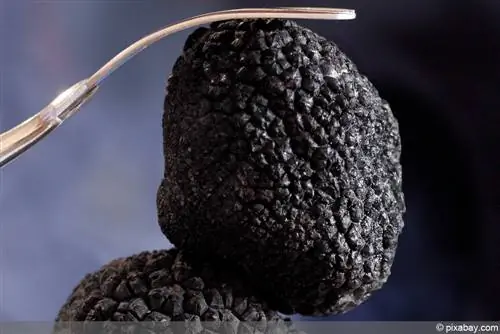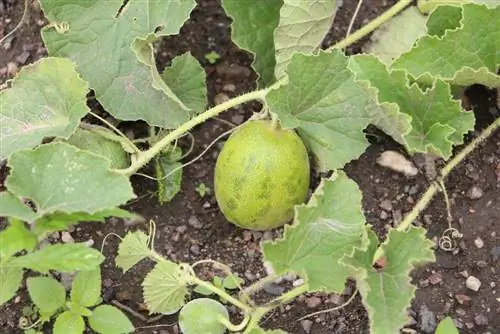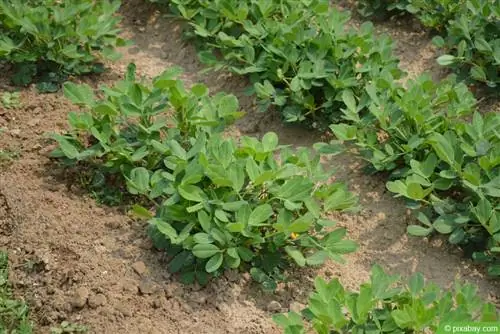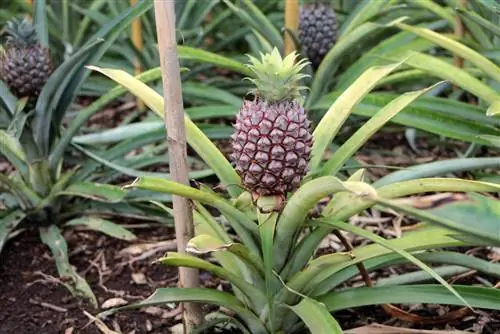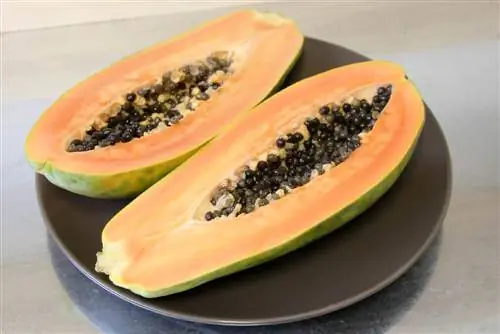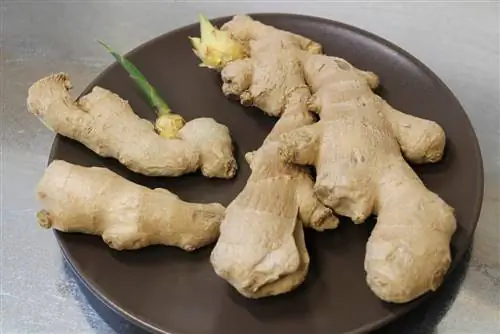- Author admin [email protected].
- Public 2023-12-17 03:39.
- Last modified 2025-01-24 12:45.
Truffles are an integral part of fine dining. The delicious mushrooms - more precisely their fruiting bodies - bring a delicate hazelnut aroma to many dishes, are used in sweet dishes and are extremely expensive. Around 50% of the truffles eaten worldwide come from cultivation and are not collected in nature. You can also grow the mushrooms in Germany.
Forgotten Sites and Conservation
Truffles are traded at 200 to 600 euros per kilogram; in the organic segment, the delicious mushrooms may be even more expensive. Almost all truffles that are eaten in Germany are imported - growing the mushrooms is considered very complicated and natural sources are not allowed to be collected in Germany. Germany was definitely truffle country for a long time. However, the locations of the particularly sought-after Burgundy truffle, which can be used very well in the kitchen with its hazelnut aroma, were forgotten at some point between the last two world wars. And when people became interested in truffles again in Germany, they couldn't be found. Therefore, the mushrooms are now protected and may not be collected or dug up for any other reason. With one exception: special permits are occasionally granted for research purposes.
The mushrooms have not yet been well researched. It is known that different types of truffles occur naturally in Germany, which depend on the altitude and climate on the one hand, but also on the nature of the soil on the other. In principle, the mushrooms do not live alone, but enter into a symbiosis with a young tree. If they get along with the seedling, the two will get used to each other for about five to seven years. Only then does the fungus begin to form fruiting bodies. Why which fungus enters into a symbiosis with which type of tree and when (and why it sometimes doesn't work out) is still almost unknown.
Win-win situation for mushroom and tree
What many people don't know: Every tree enters into a symbiosis with different fungi in its root system. The fungi form a fine network in the soil, some of which extends over many square kilometers and includes entire forests. Through this network, the fungi make it easier for the trees to absorb nutrients and water. Conversely, the trees supply the fungi with carbohydrates that the trees generate through photosynthesis and that the fungi would otherwise have no access to. A forest is always much more than the visible network of trunks, branches and leaves above the ground. The really important communities are located underground.
Trees not only form such communities with fungi from the truffle family. Many different types of mushrooms come into question. It is not known exactly when and why which tree enters into marriage with which mushroom. But we know that an adult tree no longer forms new communities and that the fungus dies when the tree is felled. This applies to all such symbioses. Mushrooms that associate with trees in this way are also called mycorrhiza.
Truffle farming is reforestation

Truffle spores are not that easy to come by in Germany. But they are needed to help young trees form a community with the fungus. To grow truffles, seedlings are usually inoculated with truffle spores so that fungi can settle in the roots of the trees. This happens on a large scale, for example in Radolfzell on the truffle plantation of Ludger Sproll and Ulrich Stobbe. Sproll is a forest botanist and has special permission to search for truffles and analyze them for research purposes. A sample of the mushrooms he finds is frozen - and what's left can then be used for the plantation he and Stobbe set up. Trees and shrubs that are native to Germany are vaccinated:
- various oak species
- different types of beech trees
- Hazel bushes
- Spruce
The seeds used basically come from Germany and are usually organically grown. Or from the wild. A great deal of effort is being made in Radolfzell to not only settle regionally different truffles, but also to establish them. Both in nature and on the market. Monocultures are undesirable, there is already diversity in the planting halls in Radolfzell. The small trees grow along with the normally unwanted weeds in light-flooded halls full of insects; only a few spiders keep tree pests at bay. This is also intentional, because the mushrooms only feel comfortable as long as the trees feel comfortable. And they need natural diversity.
If you are interested in growing truffles, you cannot order truffle spores here, only seedlings. So every private truffle farm is about building up a piece of forest. And so that the person feels comfortable in the new location, research is carried out into where exactly the trees should be located. The type of truffle vaccinations ultimately depends on the location.
Tip:
Truffle farming requires patience!
The trees will need a few years until they feel comfortable enough for the mushrooms to form fruiting bodies in their roots and can be harvested. During this time, all future truffle farmers must exercise patience. Since both the roots of the trees and the fine network of fungi are very sensitive, you should avoid drilling test holes in the soil around the tree. A truffle search dog is better suited for the search, as it only strikes where there is actually a fruiting body in the ground that is ready to be harvested.
Why dog instead of pig?

Pigs have an excellent nose and are actually superior to dogs in this respect. They can detect the fruiting bodies of truffles in the ground because they love to eat the mushrooms themselves. However, pigs are difficult to train, rather slow and not very agile. Therefore, they have now been replaced by well-behaved truffle dogs:
- Dogs are easy to train.
- Dogs are agile and happy to move.
- Dogs are playful and can be kept as family pets.
- Dogs dig specifically and cause little damage to trees and fungi.
- Dogs don't eat truffles, but wait for their reward.
Such a truffle dog is, for example, the Lagotto, whose appearance is somewhat reminiscent of the poodle. But other hunting dogs are also possible. The prerequisites are obedience, a good nose and enjoyment of challenges.
Special requirements for the soil
Mushrooms are sensitive. Anyone who thinks of mushrooms as mold, which grows pretty much everywhere, might not even assume that: But truffle cultures are very demanding when it comes to the soil. You want calcareous soils that have a pH greater than 7. A value of 8 seems to be optimal. Truffles like it slightly alkaline, and the soil must be loose. Good ventilation is a prerequisite for he althy growth of trees and fungi. Clayey soils tend not to like truffles. The soil must not be too wet because the mushrooms cannot tolerate waterlogging. But they don't like drought either. Burgundy truffles are mostly grown in Germany because they get along very well with the climate, soil and local trees. In general, other types of truffles can also be used in the garden.
Coniferous plants often cause the soil to become acidic, which is why truffles are rarely found near coniferous and mixed forests. Covering only with deciduous trees seems ideal, even if spruce trees with truffle inoculations are offered in Radolfzell. Climatically, truffles prefer locations with light ground frost, which only occurs for a short time. Prolonged negative temperatures in the double-digit range cause the fruiting bodies to die, while negative temperatures in the single-digit range promote the growth of the fruiting bodies.
It is generally said that truffles feel very comfortable near aromatic herbs. This not only applies in the kitchen, but can also apply as a rule of thumb for growing in the garden: If the soil is suitable for growing tasty (and fragrant) culinary herbs, truffles will probably also feel at home there. The truffles should not be left too dry; their tree especially needs water. This is especially true in the phase immediately after planting.
The tree needs the right location
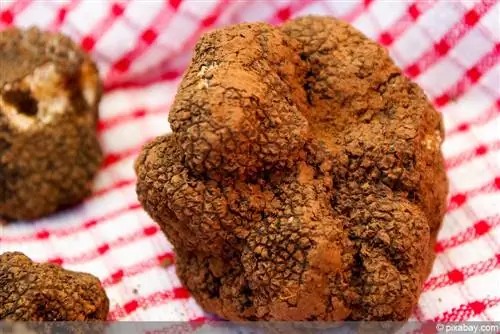
Trees like truffles need space to grow. You should always choose a location that is good for the tree. The distance to the nearest tree should be at least five meters in all directions. This means that the tree and mushroom have enough space for the next few years and there is no need to dig and replant. Because that would destroy the fine network that the fungi build in the soil. For the benefit of the tree, a watering ring can be left directly around the tree, and of course the tree is watered immediately after planting. Nothing more is actually necessary at first. The natural vegetation that shares a habitat with trees and mushrooms will appear on its own over the next few months and years.
Now you should make sure that the vegetation directly under the tree does not become too dense and that the soil is well ventilated. In the open field, the latter should of course be the case thanks to the organisms living in the soil, namely earthworms and related species. The ideal time to plant the tree is in autumn. This can also happen in spring, before the first leaf shoots. A location with summer temperatures of around 17° C to 40° C and a temperature average of around -5° C in winter is considered ideal for truffles and trees.
The temperatures shouldn't get any lower in winter, the mushrooms don't like that. Mixed cultures of different deciduous trees that have been inoculated with truffle spores are particularly promising. However, hazelnut bushes require a much higher amount of work: the ground around these bushes has to be cleaned in autumn. Falling leaves and branches acidify the soil, which the truffles don't like.
Truffles grow slowly
If the roots of the young tree have been inoculated with truffle spores, the fungus will form a fine network of hyphae over the next few months and years. This is the so-called mycelium. Five years will pass before the first truffles can be harvested because the fungus takes a long time to actually form fruiting bodies. The best time to harvest mushrooms is somewhere between autumn and winter. Depending on the climate, soil and current weather conditions, it can extend from July to February of the following year. During all these months, the fungus continues to produce fruiting bodies underground that can be harvested.
The truffle dog determines whether there are ready-to-harvest truffles underground. If you don't have such a trained dog, you can carefully remove the upper layers of soil yourself by hand and take a look:
- Do not use shovels or other equipment!
- Carefully loosen the soil with gloved fingers!
- Always only move the upper layers of the earth!
- Keep pushing the earth back carefully!
The procedure is sometimes reminiscent of archaeological excavations, which are carried out with great sensitivity and, above all, slowly. For a tree of normal to stately size, you can expect around one kilogram of truffles per harvest.
Not every truffle is one
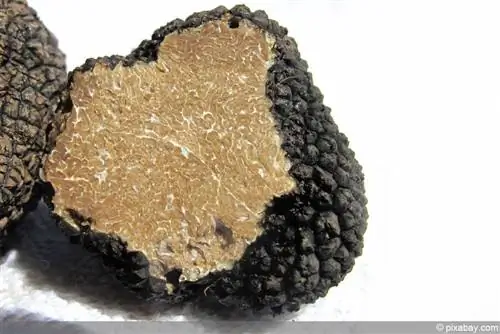
The truffle or the truffle (the German language is not clear on this) is actually a very special type of mushroom and basically grows underground. In popular parlance and in general in the kitchen, other mushrooms that are not even remotely related to true truffles are also referred to as such. Sometimes this even applies to above-ground fungi or those that are known to be tree pests. But that's not what we're talking about here; only real truffles are interesting for growing in the garden. However, other mushrooms can be used in the kitchen, which are sold as truffles and may be much cheaper.
Better no competition
Since young trees and their truffles have not yet bonded properly, the seedlings should be planted at a sufficient distance from deciduous and mixed forests. Because every tree, every forest has its own fungal culture, which of course also integrates young trees and enters into a symbiosis with them. This competition is not good and can cause a tree that has not yet been established to forget its vaccination. Fruit trees, on the other hand, are harmless because they live together with completely different fungal cultures than the typical truffle trees.

